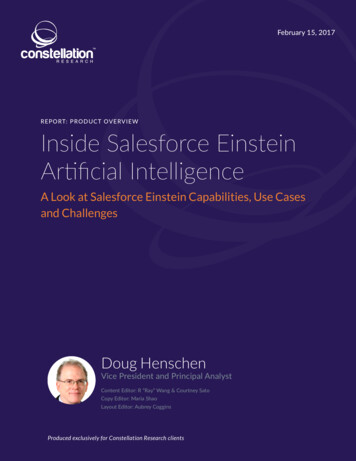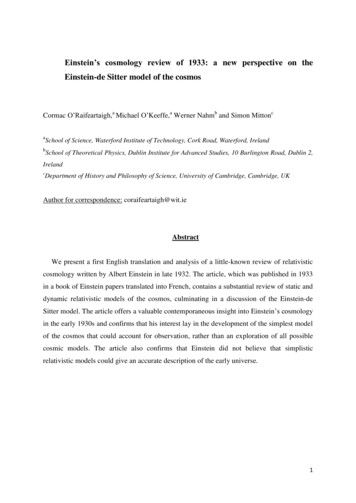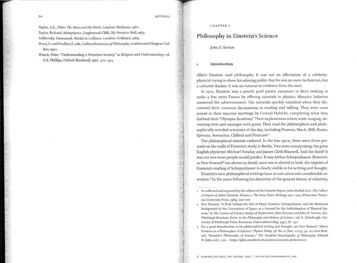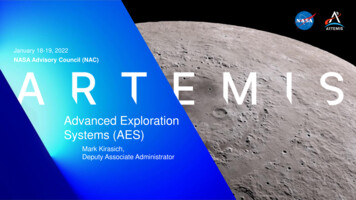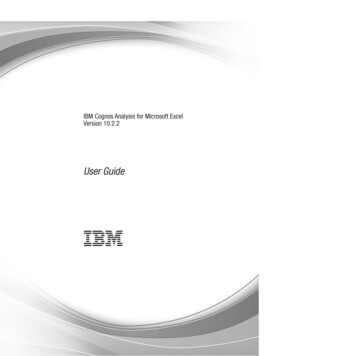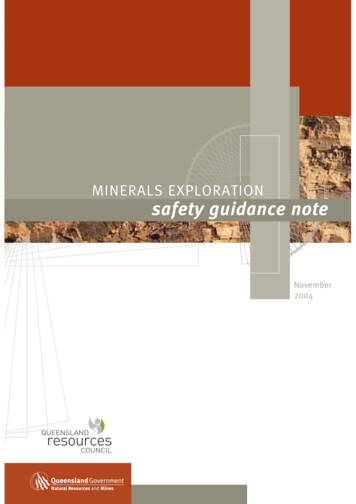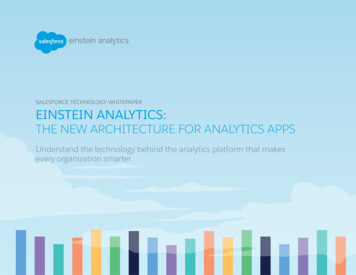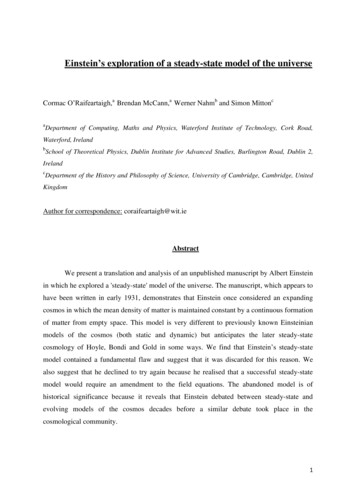
Transcription
Einstein’s exploration of a steady-state model of the universeCormac O’Raifeartaigh,a Brendan McCann,a Werner Nahmb and Simon MittoncaDepartment of Computing, Maths and Physics, Waterford Institute of Technology, Cork Road,Waterford, IrelandbSchool of Theoretical Physics, Dublin Institute for Advanced Studies, Burlington Road, Dublin 2,IrelandcDepartment of the History and Philosophy of Science, University of Cambridge, Cambridge, UnitedKingdomAuthor for correspondence: coraifeartaigh@wit.ieAbstractWe present a translation and analysis of an unpublished manuscript by Albert Einsteinin which he explored a 'steady-state' model of the universe. The manuscript, which appears tohave been written in early 1931, demonstrates that Einstein once considered an expandingcosmos in which the mean density of matter is maintained constant by a continuous formationof matter from empty space. This model is very different to previously known Einsteinianmodels of the cosmos (both static and dynamic) but anticipates the later steady-statecosmology of Hoyle, Bondi and Gold in some ways. We find that Einstein’s steady-statemodel contained a fundamental flaw and suggest that it was discarded for this reason. Wealso suggest that he declined to try again because he realised that a successful steady-statemodel would require an amendment to the field equations. The abandoned model is ofhistorical significance because it reveals that Einstein debated between steady-state andevolving models of the cosmos decades before a similar debate took place in thecosmological community.1
1. IntroductionIn the course of our research into Einstein’s cosmology in the early 1930s,1 werecently came upon an Einsteinian model of the cosmos that he did not publish. This model isset out in a signed, four-page handwritten manuscript entitled “Zum kosmologischenProblem” in the Albert Einstein Archives of the Hebrew University of Jerusalem (Einstein1931a). Until now, the manuscript was understood to be a draft of the paper “Zumkosmologischen Problem der allgemeinen Relativitätstheorie“, published by Einstein in thejournal Sitzungsberichte der Königlich Preussischen Akademie der Wissenschaften (Einstein1931b).2 However, on examining the manuscript we found that it features a model of thecosmos strikingly different to the Sitzungsberichte paper, despite some similarities in title andopening paragraphs (figure 1).The manuscript indicates that Einstein once explored a model of an expanding cosmosin which the density of matter remains constant due to a continuous formation of matter inempty space. This model is very different to other Einsteinian models of the cosmos, such ashis early model of a static universe (Einstein 1917) or his later models of an expanding,evolving universe (Einstein 1931b, Einstein and de Sitter 1932). However, the modelanticipates the well-known steady-state theories of Fred Hoyle, Hermann Bondi and TommyGold (Hoyle 1948; Bondi and Gold 1948).We present a guided tour of Einstein’s steady-state model in section 2 of this paperand discuss a likely date for the work in section 3. We consider possible reasons forEinstein’s abandonment of the model in section 4, not least a fundamental flaw in thederivation. Other steady-state models of the cosmos are discussed in section 5, and weconsider Einstein’s steady-state theory in the context of his philosophy of cosmology insection 6. Our translation and transcription of the original manuscript is provided as anAppendix by kind permission of the Albert Einstein Archive of the Hebrew University ofJerusalem.12See (O’Raifeartaigh and McCann 2014).This point has been confirmed by the founding editor of the Einstein Papers John Stachel (Stachel 2013).2
2. A guided tour of the manuscript3The manuscript begins with Einstein recalling the well-known problem of gravitationalcollapse in a Newtonian universe. This starting point is similar to Einstein’s seminalcosmological paper of 1917 (Einstein 1917), although he now includes a reference to thework of Hugo Seeliger:“It is well known that the most important fundamental difficulty thatemerges when one asks how the stellar matter fills up space in very largedimensions is that the laws of gravity are not in general consistent with thehypothesis of a finite mean density of matter. At a time when Newton’stheory of gravity was still generally accepted, Seeliger had for this reasonmodified the Newtonian law by the introduction of a distance function that,for large distances r, diminished considerably faster than 1/r2.”Einstein points out that a similar problem arises in relativistic models of the cosmos, andrecalls his introduction of the cosmological constant to the field equations of relativity torender them consistent with a static universe of constant radius and matter density:“This difficulty also arises in the general theory of relativity. However, Ihave shown that this can be overcome by the introduction of the so-called“λ–term” to the field equations. The field equations can then be written inthe form(( ))()At that time, I showed that these equations can be satisfied by a sphericalspace of constant radius over time, in which matter has a density ρ that isconstant over space and time.”In the next part of the manuscript, Einstein suggests that this static model now seemsunlikely:“It has since transpired that this solution is almost certainly ruled out forthe theoretical comprehension of space as it really is”We note that Einstein dismisses his static model for two separate reasons. First, he commentson the existence of dynamic solutions and that his static solution was found to be unstable:“On the one hand, it follows from investigations based on the sameequations by - and by Tolman that there also exist spherical solutions with a3We suggest this section be read in conjunction with our translation of the manuscript in the Appendix3
world radius P that is variable over time, and that my solution is not stablewith respect to variations of P over time.”The blank in the sentence above representing theoreticians other than Tolman who suggesteddynamic solutions is puzzling as Einstein was unquestionably aware of the cosmologicalmodels of both Friedman and Lemaître.4 Einstein also neglects to make it clear from whatresearch it follows that his static solution is unstable, although this is very likely a referenceto Eddington’s paper on the subject (Eddington 1930). These points are discussed further insection 3.Einstein’s second reason for ruling out his former static solution concerned the recentastronomical observations of Edwin Hubble:“On the other hand, Hubbel’s [sic] exceedingly important investigationshave shown that the extragalactic nebulae have the following twoproperties:1) Within the bounds of observational accuracy they are uniformly distributedin space2) They possess a Doppler effect proportional to their distance”We note that Hubble’s name is misspelt throughout the manuscript, as in the case ofEinstein’s Sitzungsberichte paper of 1931 (1931b). This may indicate that Einstein was notfully familiar with Hubble’s work, as has been argued for the latter case (Nussbaumer andBieri 1996, Nussbaumer 2014). We also note that Einstein uses the term ‘Doppler effect’rather than radial velocity, suggesting a qualified acceptance of Hubble’s observations asevidence for a cosmic expansion.5 Remarking that the dynamic models of de Sitter andTolman are consistent with Hubble’s observations, Einstein then articulates a problemassociated with their models:“De Sitter and Tolman have already shown that there are solutions toequation (1) that can account for these observations. However the difficultyarose that the theory unvaryingly led to a beginning in time about 1010-1011years ago, which for various reasons seemed unacceptable.”We note that there is again no reference to the evolving models of Friedman or Lemaître(Friedman 1922, 1924; Lemaître 1927). The “various reasons” is almost certainly a referenceto the fact that the estimated timespan of dynamic models was not larger than the ages of4Einstein’s reaction to each is well-known as discussed in (Nussbaumer 2014).Two of us have argued elsewhere that this caution is typical of Einstein’s approach to cosmology in these years(O’Raifeartaigh and McCann 2014).54
stars as estimated from astrophysics or the age of the earth as estimated from radioactivity.6However, we note that the sentence is a little ambiguous; it is possible that Einstein’s‘difficulty’ also refers to the notion of a beginning for the universe. Indeed, it is quite curiousthat the problem of the singularity is not specifically cited as a motivation for the model ofthis manuscript, as discussed in section 6.In the third part of the manuscript, Einstein explores an alternative solution to thefield equations that could also be compatible with Hubble’s observations – namely, anexpanding universe in which the density of matter does not change over time:“In what follows, I would like to draw attention to a solution to equation (1)that can account for Hubbel’s [sic] facts, and in which the density isconstant over time. While this solution is included in Tolman’s generalscheme, it does not appear to have been taken into consideration thus far.”The reference to “Tolman’s general scheme’’ is significant as the analysis to follow bearssome similarities to a paper by Tolman in which the cosmic expansion is suggested to arisefrom a continuous transformation of matter into radiation (Tolman 1930).Einstein starts his analysis by choosing the metric of flat space expandingexponentially:“I leteαt()( )This manifold is spatially Euclidean. Measured by this criterion, thedistance between two points increase over time as; one can thus accountfor Hubbel’s Doppler effect by giving the masses (thought of as uniformlydistributed) constant co-ordinates over time.”To modern eyes, equation (2) represents the metric of the de Sitter universe.7 A similar lineelement was employed by Tolman in the paper mentioned above (Tolman 1930) andEinstein’s choice of metric may owe something to the latter work. However, it should benoted that the hypothesis of a constant rate of matter creation in any case implies a metric thatis spatially flat and exponentially expanding.8 Einstein also notes that the metric is invariant:6Einstein’s view of the timescale problem is spelt out in detail in his later review of dynamic models (Einstein1945).7This was first shown by Robertson in 1928 (Robertson 1928).8A constant rate of matter creation implies spatial flatness because the creation rate is affected by spatialcurvature (k/R2) and the radius is not constant. A constant Hubble parameter ̇ is also implied, from which it5
“Finally, the metric of this manifold is constant over time. For it istransformed by applying the substitutiont' t - τ (τ const)eαt’ ()We note the apparent sign error in the last equation above, an error that may have ledto a miscalculation in the analysis described below.Assuming a low velocity of masses relative to the co-ordinate system and that thegravitational effects of the radiation pressure are negligible, Einstein constructs the matterenergy tensor in a manner analogous to his seminal paper of 1917 (Einstein 1917):“We ignore the velocities of the masses relative to the co-ordinate system aswell as the gravitational effect of the radiation pressure. The matter tensoris then to be expressed in the form()or( )”whereFrom equations (1) - (3), Einstein derives two simultaneous equations and, eliminating thecosmological constant, deduces a relation between the expansion coefficient α and the matterdensity ρ:“ Equations (1) yield:( )or( )”We note an inconsistency regarding the coefficient of α2 in the first of the simultaneousequations above. While a value of 9/4 is implied by the equations that follow, it appears tohave been amended to -3/4 (see figure 2). The correction leads to the null result ρ 0 insteadof equation (4), exposing a fundamental flaw in the model as discussed in section 4.follows that the expansion must be exponential. It is very possible that Einstein realised this independently ofTolman.6
In the original draft of the model, Einstein concludes from equation (4) that thedensity of matter remains constant and is related to the cosmic expansion:“The density is therefore constant and determines the expansion apart fromits sign.”Hence Einstein assumes that the expansion is determined by the creation of matter, whileTolman suggested that it was driven by a transformation of matter into radiation (Tolman1930). However, Einstein does not attempt to use Hubble’s measurements to quantify the rateof expansion, unlike Tolman.In the final part of the manuscript, Einstein proposes a mechanism to allow thedensity of matter remain constant in a universe of expanding radius - namely, the continuousformation of matter from empty space:“If one considers a physically bounded volume, particles of matter will becontinually leaving it. For the density to remain constant, new particles ofmatter must be continually formed in the volume from space.”This proposal anticipates the ‘creation field’ or ‘C-field’ of Fred Hoyle in some ways (seesection 5 below). However, Einstein has not introduced a term representing this process intothe field equations (1). Instead he associates the continuous formation of matter with thecosmological constant, commenting that the latter ensures that space is not empty of energy:“The conservation law is preserved since by setting the λ-term, space itselfis not empty of energy; its validity is well-known to be guaranteed byequations (1).”Thus, in this model of the cosmos, Einstein proposes that the cosmological constant assignsan energy to empty space that is associated with the creation of matter. However, theproposal is fundamentally flawed because the lack of a specific term representing mattercreation in fact leads to the null solution ρ 0. We suggest that Einstein recognized thisproblem on revision and set the model aside rather than pursue more contrived steady-statesolutions, as discussed in section 6.3. Historical remarks: dating the manuscript7
The manuscript under discussion has been assigned the year 1931 at the Albert EinsteinArchive. However, this dating is no longer certain as the manuscript was mistaken for a draftof a different paper until now (see introduction ).It is instructive to attempt to date the manuscript from its contents. Thestatement“ Hubbel’s exceedingly important investigations have shown that the extra-galacticnebulae possess a Doppler effect proportional to their distance” (see section 2) gives confidencethat it was written after Hubble’s seminal publication of 1929 (Hubble 1929).9 Indeed, it isgenerally thought that Einstein’s interest in cosmology was rekindled by Hubble’s seminalobservations of the recession of the galaxies, and by his three-month stay in the United Statesfrom December 1930 to March 1931 (Nussbaumer and Bieri 2009, chapter 14; Bartusiak2009, chapter 16; Eisinger 2012, chapter 5) . Much of this trip was spent at Caltech, andincluded a meeting with Edwin Hubble and other astronomers at the Mount WilsonObservatory.10 Press reports of seminars given by Einstein at Caltech certainly suggest that heviewed Hubble’s observations as likely evidence for an expanding universe. For example,The New York Times reported Einstein as commenting that “New observations by Hubble andHumason concerning the redshift of light in distant nebulae make the presumptions near that thegeneral structure of the universe is not static” (AP 1931a) and “The redshift of the distant nebulaehave smashed my old construction like a hammer blow”(AP 1931b).Einstein had many interactions with the theoretician Richard Tolman at Caltech andgreatly admired Tolman’s work on relativity.11 Thus, Einstein may have been influenced byTolman’s cosmology and we have already noted in section 2 that the manuscript underdiscussion bears some similarities to Tolman’s ‘annihilation’ model of 1930 (Tolman 1930).Finally, Einstein’s manuscript is written on American paper, making it highly improbable thatit was written before his arrival in the United States in January 1931.12As regards an upper bound for the date of the manuscript, it is different in both styleand content to the cosmic models published by Einstein in April 1931 (Einstein 1931b)13 and1932 (Einstein and deSitter 1932). In the latter papers (known as the Friedman-Einstein andthe Einstein-deSitter models respectively), Einstein assumes that the mean density of matterdecreases with increasing cosmic radius and removes the cosmological constant term fromthe field equations, pointing out that it was only introduced to keep the universe static.9It is very unlikely that Einstein knew of Hubble’s observations before this date, see (Nussbaumer 2014).See (Bartusiak 2009, p251-256; Eisinger 2012, p 109-115),11See (Nussbaumer and Bieri 2014; Eisinger 2012, p114).12We thank Barbara Wolff of the Albert Einstein Archives for confirming this point13It is known that this model was written in early April 1931 (see Eisinger 2012) chap 7.108
Einstein also employs the analysis of Alexander Friedman to quantify the models of thesepapers, i.e., uses the Friedman differential equations in conjunction with Hubble’sobservations to determine values for the radius and matter density of the universe.14 Bycontrast, the cosmological constant is not removed from the field equations in the manuscriptunder discussion, but assigned a new role; there is no reference to Friedman’s analysis, noattempt to quantify the model and no reference to Einstein’s published models of 1931 and1932. Thus, it seems very likely that this manuscript precedes the Friedman-Einstein andEinstein-deSitter models, i.e., was written sometime in early 1931, and represents Einstein’sfirst attempt at a cosmic model in the wake of astronomical evidence for an expansion on thelargest scales.4. Why was Einstein’s steady-state model not published?We note first that there is no mention of steady-state solutions in Einstein’s laterdiscussions of cosmic models (Einstein 1931b, Einstein and de Sitter 1932, Einstein 1945),nor have we been able to find a reference to the manuscript under discussion in Einstein’sletters, diaries or other personal papers. This silence indicates that he decided against themodel, rather than simply mislaid the manuscript during his travels or neglected to publish it.We suggest that the model was discarded because it contains a fundamental flaw. Inparticular, we have been unable to reproduce Einstein’s derivation of equation (4) fromequations (1) - (3). Although a value of 9/4 is implied for the coefficient of α2 in the first ofthe simultaneous equations by the two equations after it, we find a value of -3/4 for thiscoefficient on deriving the equations from first principles. The latter value renders the lefthand sides of the simultaneous equations identical, giving the null solution ρ 0 instead ofequation (4). Close scrutiny of figure 2 suggests that the co-efficient of α2 in the first equationhas indeed been amended to -3/4; it seems that Einstein discovered the error at a later point,realised the model led to a trivial solution and set the work aside without correcting equation(4).15With modern eyes, it is easy to see why Einstein’s steady-state model leads to a nullsolution; the fundamental problem is that he has not included a specific term in the analysis14Two of us have analyzed the paper of 1931in some detail (O’Raifeartaigh and McCann 2014).Deriving the equations from first principles, we find that that Einstein’s error probably arose from a sign errorin his calculation of the Christoffel coefficients, an error that may be a further indication that the manuscriptrepresents Einstein’s first attempt at a relativistic model of the cosmos in many years.159
representing the hypothesised creation of matter. This leads one to ask why Einstein did notattempt a more sophisticated steady-state solution by introducing a ‘matter-creation’ terminto the field equations. We suggest that Einstein may have decided that such an approachwas rather contrived in comparison with evolving models, as discussed in section 6 below.5. On steady-state models of the cosmosWe note first that steady-state models of the universe were considered many times in20th century cosmology. In 1918, the American physicist William MacMillan proposed acontinuous creation of matter from radiation in order to avoid a gradual ‘running down’ ofthe universe due to the conversion of matter into energy in stellar processes (MacMillan1918, 1925). MacMillan’s proposal was enthusiastically received by Robert Millikan, whosuggested that the process might be the origin of cosmic rays (Millikan 1928). The idea of acontinuous creation of matter from radiation was also considered by Richard Tolman as ameans of introducing matter into the empty de Sitter universe, although he saw the idea asrather improbable (Tolman 1929).Other physicists considered the possibility of a continuous creation of matter fromempty space. In 1928, James Jeans speculated that matter was continuously created in thecentre of the spiral nebulae: “The type of conjecture which presents itself, somewhat insistently,isthat the centres of the nebulae are of the nature of “singular points”, at which matter is poured intoour universe from some other spatial dimension .so that they appear as points at which matter ispoured into our universe from some other, and entirely extraneous spatial dimension, so that, to adenizen of our universe, they appear as points at which matter is continually created” (Jeans 1928, p360). Similar ideas of continuous creation were explored by the Swedish scientist SvanteArrhenius and the German chemist Walther Nernst (Arrhenius 1909; Nernst 1928).16However, these theories did not concern the creation of matter in an expanding universe.The concept of an expanding universe that remains in a steady-state due to acontinuous creation of matter is most strongly associated with the Cambridge physicists FredHoyle, Hermann Bondi and Thomas Gold. In the late 1940s, these physicists becameconcerned with well-known problems associated with evolving models of the expandingcosmos. In particular, they noted that the evolving models predicted a cosmic age that wasproblematic, and disliked Lemaȋtre’s idea of a universe with an explosive beginning16See (Kragh 1996) p143-162 for a review of steady-state cosmologies in the early 20th century.10
(Lemaȋtre 1931).17 In order to circumvent these, and other problems,18 the trio explored theidea of an expanding universe that does not evolve over time, i.e., a cosmos in which themean density of matter is maintained constant by a continuous creation of matter from thevacuum (Hoyle 1948; Bondi and Gold 1948). 19In the case of Bondi and Gold, the proposal of a steady-state model followed fromtheir belief in the ‘perfect cosmological principle’, a principle that stated that the universeshould appear the same to all observers at all times. This principle led to the postulate of acontinuous creation of matter in order to sustain an unchanging universe. While the ideabears some similarity to Einstein’s steady-state model, it is difficult to compare the modelsdirectly because the Bondi-Gold theory was not formulated in the context of generalrelativity.20On the other hand, Fred Hoyle constructed a steady-state model of the cosmos bymeans of a daring modification of the Einstein field equations (Hoyle 1948, Mitton 2011,chapter 5). Replacing Einstein’s cosmological constant with a new ‘creation-field’ term Cik,representing the continuous formation of matter from the vacuum, Hoyle obtained theequation()( )The creation-field term allowed for an unchanging universe but was of importance only onthe largest scales, in the same manner as the cosmological constant. (Note that the perfectcosmological principle followed as a consequence of Hoyle’s model, rather than a startingassumption; we also note that Hoyle also demonstrated that his model necessitated a lineelement of de Sitter form).Hoyle’s steady-state model violated the conservation of energy. However, the theorywas more quantitative than the Bondi-Gold model and he extracted estimates of 1.8 x 1027 cmand 5x10-28 g/cm3 for the radius and mean matter density of the universe respectively; thesevalues were very similar to the predictions of evolving models (Eddington 1930, Einstein and17That Einstein did not consider the problem of cosmic origins in this manuscript is another indication that itwas written before 1932 (see Eddington 1931 for example).18Hoyle was also unconvinced by Gamow’s postulate of nucelosynthesis in the infant universe and concernedabout the problem of the formation of galaxies in an expanding universe (Hoyle 1948).19That the problem of cosmic origins is not a motivation for in Einstein’s steady –state model is anotherindication that the manuscript was written before 1932, i.e. before the debate of Eddington and Lemaȋtre’s onthe subject (Eddington 1931; Lemaȋtre 1931)20Bondi and Gold took the view that it was not known whether it was appropriate to apply general relativity tothe cosmos on the largest scales (see Bondi 1952, p146).11
de Sitter 1932). In the years that followed, Hoyle’s steady-state model became the dominantsteady-state theory because it could be quantified and refined within the context of thegeneral theory of relativity.21It could be argued that Einstein’s steady-state theory anticipates that of Hoyle in someaspects; however, they are crucially different because of the lack of a specific term in thefield equations in Einstein’s model to enable the continuous formation of matter. Anotherpossibility for Einstein would have been to include a term representing the continuousformation of matter within the matter-energy tensor of the field equations, as suggested byWilliam McCrea in a later steady-state theory (McCrea 1951). Instead, Einstein set hissteady-state model to one side, never to return.As is well known, a significant debate was waged between steady-state and evolvingmodels of the cosmos during the 1950s and 1960s (Kragh 1996, chapter 5; Mitton 2011,chapter 7). Eventually, steady-state models were ruled out by astronomical observations22that showed unequivocally that we inhabit a universe that is evolving over time.23 We notethat there is no evidence to suggest that any of the steady-state theorists were aware of themanuscript under discussion; indeed, it is likely that they would have been greatly intriguedto learn that Einstein had once attempted a steady-state model.6. On Einstein’s philosophy of cosmologyIt should come as no great surprise that when confronted with empirical evidence foran expanding universe, Einstein once considered a stationary or steady-state model of theexpanding cosmos. There is a great deal of evidence that Einstein’s philosophical preferencewas for an unchanging universe, from his introduction of the cosmological constant to thefield equations in 1917 to keep the universe static24 to his well-known hostility to thedynamic models of Friedman and Lemaître when they were first suggested.25 Indeed, a model21One problem was that the model became very complicated when density perturbations were introduced.The principle observations were the discovery that the distribution of galaxies was significantly different inthe distant past, and the discovery of the cosmic microwave background. See (Kragh 1996) chaper 7 for areview.23Alternative versions of steady-state models were suggested, but failed to convince the community (Kragh1996) chapter 7.24It could be argued that this choice was as much philosophical as empirical because there was no guarantee thatan expansion on the largest scales would be detectable by astronomy.25An account of Einstein’s reaction to the models of Friedman and Lemaitre can be found in chapters 7 and 9respectively of (Nussbaumer and Bieri 2009).2212
of an expanding cosmos in which the density of matter remains unchanged seems a naturalsuccessor to Einstein’s static model of 1917, at least from a philosophical point of view.However, such a steady-state theory requires the assumption of a continuous creationof matter and, as Einstein discovered in this manuscript, a successful model of the latterprocess was not possible without some alteration to the field equations. On the other hand, anexpanding universe of varying matter density could be described without any suchassumption – and indeed without the cosmological constant,26 as Einstein suggested in theFriedman-Einstein and Einstein-deSitter models (Einstein 1931b; Einstein and de Sitter1932). Thus it seems very probable that Einstein decided against steady-state solutionsbecause they were more contrived than evolving models of the cosmos. This suggestion fitsvery well with our view of Einstein’s pragmatic approach to cosmology in these years.27It is also possible that Einstein decided against steady-state models on empiricalgrounds, i.e., on the grounds that there was no observational evidence to support the postulateof a continuous formation of matter from empty space. It is interesting that, when asked tocomment on Hoyle’s steady-state model many years later, Einstein is reported to havedismissed the theory as “romantic speculation” (Michelmore 1962, p253). This criticism isconfirmed in a letter written by Einstein to the physicist Jean Jacques Fehr in 1952. Einsteinseems highly sceptical of Hoyle’s model, and in particular of the postulate of a continuouscreation of matter from the vacuum: “Die kosmologischen Spekulationen von Herrn Hoyle, welche eineEntstehung von Atomen aus dem Raum voraussetzen, sind nach meiner Ansicht viel zu wenig begründet, umernst genommen zu werden”or “The cosmological speculations of Mr Hoyle, which presume thecreation of atoms from e
Einstein’s abandonment of the model in section 4, not least a fundamental flaw in the derivation. Other steady-state models of the cosmos are discussed in section 5, and we consider Einstein’s steady-state theory in

